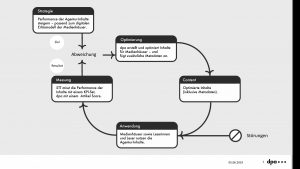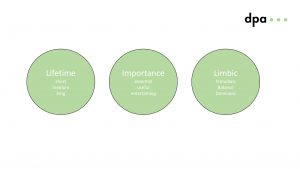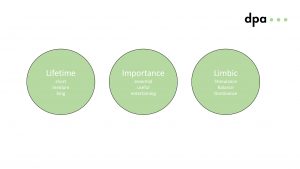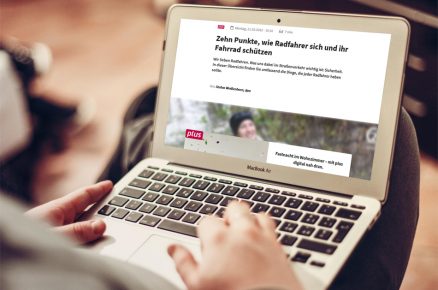+++ ENGLISH VERSION BELOW+++
Mehr Abos, mehr Leserumsätze: Viele Medienhäuser in Deutschland setzen bei der Steigerung ihrer Digitalerlöse auf Premium-Inhalte. Das Team von dpa Performing Content hat es sich zum Ziel gesetzt, seine Kunden bei der Gewinnung digitaler Abonnements zu unterstützen. Dafür entwickelten wir im Rahmen des Projekts C-POP eine neuartige Content-Strategie, die Daten und die Emotionen der Leserinnen und Leser zusammenbringt.
Immer mehr Menschen sind bereit, für hochwertige journalistische Inhalte zu zahlen. Die Herausforderung für Medienhäuser besteht jetzt darin, die richtigen Geschichten zum idealen Zeitpunkt der passenden Leserschaft im bestmöglichen Nutzungskontext anzubieten. Nur so können Verlage ihre Leser zu zahlenden Abonnenten machen und damit ihren „Story Driven Reader Revenue“ als langfristiges valides Erlösmodell weiter ausbauen.
Hierfür starteten die dpa unter der Leitung von Chief Digital Officer Meinolf Ellers und ihre finnische Partneragentur STT das Content Performance Optimization Program, kurz C-POP. In dem Projekt entwickelten wir eine neue Art der Zusammenarbeit zwischen Nachrichtenagentur und Medienhäusern und wandten diese – auf deutscher Seite – mit NOZ Medien & mh:n Medien sowie der Funke Mediengruppe an.
Unter Einsatz neuer Datenanalyse- und Neuromarketing-Tools entstand ein Modell, wie Medienhäuser mit passenden Agentur-Inhalten ihre Online-Performance steigern – und somit die Chance signifikant erhöhen, neue Abonnenten zu gewinnen.
Feedback-Loop, Limbic®, Metadaten – Die 3 Säulen von C-POP
Das mit Mitteln der Google News Initiative unterstützte Vorhaben hatte drei Kernaspekte:
- Automatisierter Feedback Loop zur Performance-Steigerung
Damit Medienhäuser mit Agentur-Inhalten ihre Performance steigern und somit neue Abonnenten gewinnen können, haben wir einen neuen, automatisierten Workflow zwischen Agentur und Medienhaus eingeführt: den Feedback-Loop. NOZ Medien & mh:n Medien sowie die Funke Mediengruppe stellten uns hierfür Nutzungsdaten zur Verfügung. So konnten wir die Daten analysieren und die Inhalte demnach optimieren. Der ständige Datenaustausch zwischen uns und den Medienhäusern hat die Performance der Inhalte deutlich gesteigert. Eine Win-win-Situation für beide Seiten.

- Limbic® Tool für emotionsbasierte Content-Strategie
Daten alleine reichen nicht, es braucht Emotionen, um Menschen zu erreichen. Hier kam das Limbic® Modell, ein bewährtes Neuromarketing-Tool der Unternehmensberatung Gruppe Nymphenburg, zum Einsatz. dpa Performing Content adaptierte die Systematik und bildete drei Zielgruppen-Cluster :
- Balance-Zielgruppe
Diese Leser streben nach Sicherheit und Stabilität. Bei der Inhalte-Produktion konzentrierten sich die Redakteurinnen auf Ratgeber-Themen aus den Bereichen Gesundheit und Ernährung, die Texte schrieben sie in einer warmen Tonalität. Fotos in den Farben Grün und Braun sind nach dem Modell von Vorteil.
-> Ziel der Maßnahme: Conversions (Abonnements).
- Dominanz-Zielgruppe
Diese Menschen legen Wert auf Leistung und Status. Passende Ratgeber-Themen kommen u.a. aus den Bereichen Fitness und Technik. Die Texte schrieben die Redakteurinnen in einer kühlen Tonalität. Fotos in den Farben Schwarz und Rot sind vorteilhaft.
-> Ziel der Maßnahme: Conversions (Abonnements und Membership).
- Stimulanz-Zielgruppe
Bei dieser Zielgruppe dreht sich alles um Spaß und Abwechslung. Hier sprechen wir „Trendsetter“ an. Relevante Ratgeber-Rubriken sind Lifestyle und Netzwelt. Die Tonalität der Texte sollte locker sein. Die Farbwelt der Fotos ist schrill – Orange und Gelb sind passend.
-> Ziel der Maßnahme: Reichweite.
Die Arbeit mit den unterschiedlichen Zielgruppen veränderte den Prozess der Inhalte-Produktion. Die dpa-Redakteurinnen schrieben ein Thema fortan in mehreren Varianten und achteten darauf, dass Thema und Tonalität des Textes sowie die Bildsprache jeweils zur emotionalen Ansprache der Zielgruppe passten.
- Neue Metadaten für ein dynamisches Online-Angebot

Ein wesentlicher Bestandteil der Content-Strategie ist die Integration der neuen Metadaten Lifetime (Aktualität und Lebensdauer eines Inhalts), Importance (News-Typ eines Inhalts) und Limbic® (Zielgruppe eines Inhalts). Daraus entstehen Inhalte, die den Medienhäusern zur Segmentierung ihrer Leser dienen und gleichzeitig ihr Online-Angebot noch dynamischer machen. Dem Leser wiederum bieten wir mit diesen datenangereicherten Inhalten eine personalisierte Leseerfahrung.
So gut funktionieren die Zielgruppen-Inhalte in Praxis-Tests
Höhere Reichweite und Loyalität durch Zielgruppen-Ansprache
Beim Test mit der Main-Post lautete der Plan, die Zielgruppe Frauen ab 40 Jahren zu loyalisieren. Durch einen A/B-Test auf mainpost.de erreichten wir mit personalisierten bzw. auf diese Zielgruppe hin optimierten Inhalten eine viel höhere Reichweite und eine höhere Loyalität.
So funktionierte es: Das Segment der Frauen 40+ passte zur Balance-Zielgruppe. Dementsprechend optimierten die dpa-Redakteurinnen in einem sechswöchigen A/B-Test die Überschriften und Fotos der Ratgeber-Artikel. Mithilfe des Digitaldienstleisters Bineos GmbH erhielten 50 Prozent der Leserinnen ab 40 Jahren die Balance-Variante in einer speziell für sie eingerichteten Themenbox auf der Homepage ausgespielt, die andere Hälfte sah eine neutrale Variante. Gewinner war die Balance-Variante.
Zielgruppen besser verstehen, personalisierte Erfahrungen bieten
Mit NOZ Medien & mh:n Medien identifizierten wir durch die Arbeit mit drei Zielgruppen die unterschiedlichen Interessen und Bedürfnisse der Leserinnen und Leser auf noz.de. Das zeigte, wie wichtig die Personalisierung von Inhalten ist.
So lief der Test ab: Für einen A/B/C-Test produzierte die dpa mehrere Ratgeber-Artikel und formulierte für jedes Thema drei Überschriften – Balance, Dominanz und Stimulanz. In der Tabelle sind Beispiele zu sehen.
| Thema | Balance | Dominanz | Stimulanz |
| Kaffee | Wirkung, Gesundheit, Zeitpunkt: 5 Dinge, die Sie über Kaffee wissen sollten |
Energie-Kick: So schnell treibt Kaffee zu neuen Höchstleistungen an |
But first, coffee! Kaffee: 5 wichtige Dinge über dein Lieblingsgetränk |
| Achtsamkeit | Abnehmen in Corona-Zeiten: 5 Tipps, wie Sie endlich achtsamer essen |
Besser essen in Corona-Zeiten: 5 Tipps, wie Sie Ihre Ernährung unter Kontrolle behalten |
Mindful Eating in Corona-Zeiten: 5 Tipps, wie du bewusst essen lernst |
Ein Thema, drei Überschriften: Die NOZ publizierte die Artikel mit einem A/B/C-Test-Tool – mit dem Ergebnis: Jede Text-Variante fand ihre Leser. In dem Artikel über Achtsamkeit etwa bestätigte sich, dass das Thema Gesundheit und Ernährung vor allem die Balance-Zielgruppe interessierte. Der Artikel mit einer entsprechend personalisierten Überschrift schnitt im Test bei dieser Gruppe am besten ab, danach folgten die Dominanz- und dann die Stimulanz-Variante.
Personalisierte Empfehlungen durch Limbic® stärkte Leserbindung deutlich
Eine höhere Leserbindung erzielten wir mit Artikelempfehlungen, die auf die Interessen der Leser abgestimmt waren. In einem A/B-Test mit einem regionalen Partnerportal erzielten die personalisierten Empfehlungen eine größere Stickiness als die rein themenverwandten Empfehlungen. Stickiness bedeutet, Nutzer bleiben nach dem Lesen eines Artikels auf der Webseite und lesen einen weiteren Artikel.
FAZIT
Mit C-POP haben wir die redaktionellen und technischen Grundlagen für ein neues, einzigartiges Personalisierungskonzept gelegt. Segmentierung und inhaltliche Personalisierung sollten die dpa und ihre Medienkunden als langfristigen Prozess verstehen: Je mehr Daten und Informationen wir über die Leserinnen und Leser erhalten, desto präziser können wir die Zielgruppen wählen und ihnen hochwertige, passgenaue Inhalte anbieten.
Deshalb fließen die Erfahrungen und Ergebnisse von C-POP jetzt in die Entwicklung eines neuen Produkts der dpa-infocom und in das Folgeprojekt DRIVE (Digital Revenue Initiative) ein. Dabei arbeiten dpa, die Unternehmensberatung Schickler und vier Pilotverlage gemeinsam daran, mit Daten-Analysen und künstlicher Intelligenz die Nutzung redaktioneller Angebote zu steigern.
Detaillierte Ergebnisse und Informationen zum Projekt C-POP lesen Sie im kostenlosen WhitePaper „Aus Nutzern werden Abonnenten: Mit neuen Daten- und Neuromarketing-Tools relevante Inhalte produzieren und Leserumsätze steigern.”
Notizblock:
Katja Fleischmann
Leiterin Performing Content
Twitter: @FleischmannKat
LinkedIn: Katja Fleischmann
+++ ENGLISH VERSION +++
Better Performance for Digital Content: dpa and Media Companies test New Content Strategies
More subscriptions, more reader revenue: Many media houses in Germany are focusing on premium content to increase their digital revenues. The team at dpa Performing Content has set itself the goal of helping its customers gain digital subscriptions. To this end, we developed a novel content strategy as part of the C-POP project, which brings together data and the emotions of readers.
More and more people are willing to pay for high-quality journalistic content. The challenge for media companies now is to offer the right stories to the right readership at the ideal time in the best possible usage context. This is the only way for publishers to turn their readers into paying subscribers and thus further expand their „story driven reader revenue“ as a long-term valid revenue model.
To this end, dpa, under the leadership of Chief Digital Officer Meinolf Ellers, and its Finnish partner agency STT launched the Content Performance Optimization Program, or C-POP for short. In the project we developed a new form of cooperation between news agency and media companies and applied it – on the German side – with NOZ Medien & mh:n Medien as well as the Funke Mediengruppe.
Using new data analysis and neuromarketing tools, a model was created of how media houses can increase their online performance with suitable agency content – and thus significantly increase the chance of acquiring new subscribers.
Feedback Loop, Limbic®, Metadata – The 3 Pillars of C-POP
The project, supported by funds from the Google News Initiative, had three core aspects:
- Automated Feedback Loop To Increase Performance
To enable media houses with agency content to improve their performance and thus attract new subscribers, we introduced a new, automated workflow between agency and media house: the feedback loop. NOZ Medien & mh:n Medien and the Funke Mediengruppe provided us with usage data for this purpose. This enabled us to analyze the data and optimize the content accordingly. The constant data exchange between us and the media houses has significantly increased the performance of the content. A win-win situation for both sides.

- Limbic® Tool for Emotion-Based Content Strategy
Data alone is not enough, emotions are needed to reach people. This is where the Limbic® model, a proven neuromarketing tool from the Nymphenburg Group management consultancy, came in. dpa Performing Content adapted the system and formed three target group clusters:
- Balance target group
These readers strive for security and stability. In the production of the content, the editors concentrated on advice topics in the areas of health and nutrition, writing the texts in a warm tonality. Photos in the colors green and brown work well, according to the model.
-> Aim of measure: Conversions (subscriptions).
- Dominance target group
These people value performance and status. Appropriate advice topics include those in the areas of fitness and technology. The editors wrote the texts in a cool tonality. Photos in black and red work well.
->Aim of the measure: Conversions (subscriptions and membership).
- Stimulance target group
This target group is all about fun and variety. Here we address „trendsetters.“ Relevant guide categories are lifestyle and the networked world. The tonality of the texts should be relaxed. The color world of the photos is shrill – orange and yellow are appropriate.
-> Aim of the measure: reach.
Working with different target groups changed the process of content production. The dpa editors began to write a topic in several variants and made sure that the topic and tonality of the text as well as the visual language matched the emotional appeal of the target group.
- New Metadata for a Dynamic Online Offering

An essential part of the content strategy is the integration of the new metadata Lifetime (topicality and lifetime of content), Importance (news type of content) and Limbic® (target group of content). This results in content that helps media companies segment their readers and at the same time makes their online offerings even more dynamic. In turn, we offer the reader a personalized reading experience with this data-enriched content.
How Well the Target Group Content Works in Practical Tests
Greater Reach and Loyalty Through Targeting
When tested with the Main-Post, the plan was to loyalize the target group of women aged 40 and over. Through an A/B test on mainpost.de, we achieved a much higher reach and loyalty with personalized content or content optimized for this target group.
Here’s how it worked: the women 40+ segment matched the Balance target group. Accordingly, the dpa editors optimized the headlines and photos of the advice articles during a six-week A/B test. With the help of the digital service provider Bineos GmbH, 50 percent of the readers aged 40 and over were shown the Balance variant in a special topic box on the homepage, while the other half saw a neutral variant. The winner was the Balance variant.
Better Understand Target Groups, Offer Personalized Experiences
With NOZ Medien & mh:n Medien we identified the different interests and needs of the readers of noz.de by working with three target groups. This showed how important the personalization of content is.
This is how the test went: For an A/B/C test, dpa produced several guidebook articles and formulated three headings for each topic – Balance, Dominance, and Stimulance. Examples are shown in the table.
| Topic | Balance | Dominance | Stimulance |
| Coffee | Effect, health, timing: 5 things you should know about coffee |
Energy kick: This is how quickly coffee can drive you to new achievements |
But first, coffee! Coffee: 5 important things about your favorite drink |
| Mindfulness | Losing weight in corona times: 5 tips on how to finally eat more mindfully |
Better eating in corona times: 5 tips on how to keep your eating under control |
Mindful eating in corona times: 5 tips on how to learn to eat consciously |
One topic, three headlines: The NOZ published the articles using an A/B/C test tool – with the result that every text variant found its readers. The article on mindfulness, for example, confirmed that the topic of health and nutrition was of particular interest to the Balance target group. The article with an appropriately personalized headline scored best in the test with this group, followed by the Dominance and then the Stimulance variant.
Personalized Recommendations Using Limbic® Significantly Strengthen Reader Loyalty
We achieved higher levels of reader loyalty with article recommendations that were tailored to the interests of the readers. In an A/B test with a regional partner portal, the personalized recommendations achieved greater stickiness than the purely topic-related recommendations. Stickiness means that after reading an article, users stay on the website and read another article.
CONCLUSION
With C-POP we have laid the editorial and technical foundations for a new, unique personalization concept. Through the automated feedback loop, we achieved a higher reach and improved reader loyalty, which in the best-case scenario turns users into subscribers. After all, segmentation and content personalization should be a long-term process for dpa and its media customers: The more data and information we receive about our readers, the more precisely we can select target groups and offer them high-quality, tailor-made content.
For this reason, the experience and the positive results of the project will be incorporated into the development of a new dpa-infocom product and into the follow-up project DRIVE (Digital Revenue Initiative), in which dpa, the management consultancy Schickler and four pilot publishers are working together to increase the use of editorial services through data analysis and artificial intelligence.
Detailed results and information on the C-POP project can be found in the white paper, Users become subscribers: Using new data and neuromarketing tools to produce relevant content and increase reader sales. You can download it here for free.
Note:
Katja Fleischmann
Head of Performing Content
Twitter: @FleischmannKat
LinkedIn: Katja Fleischmann





